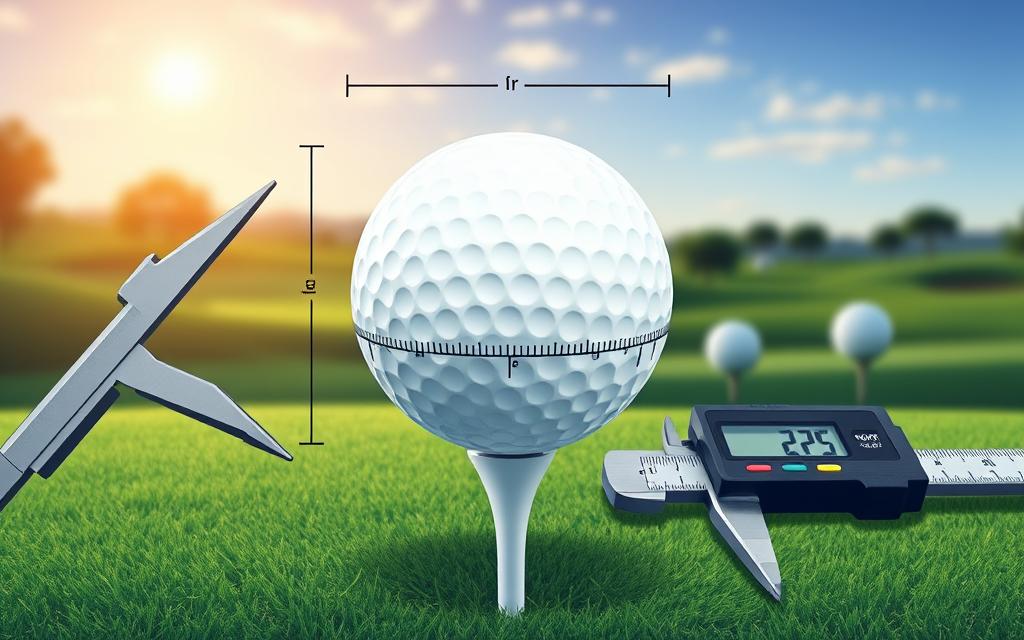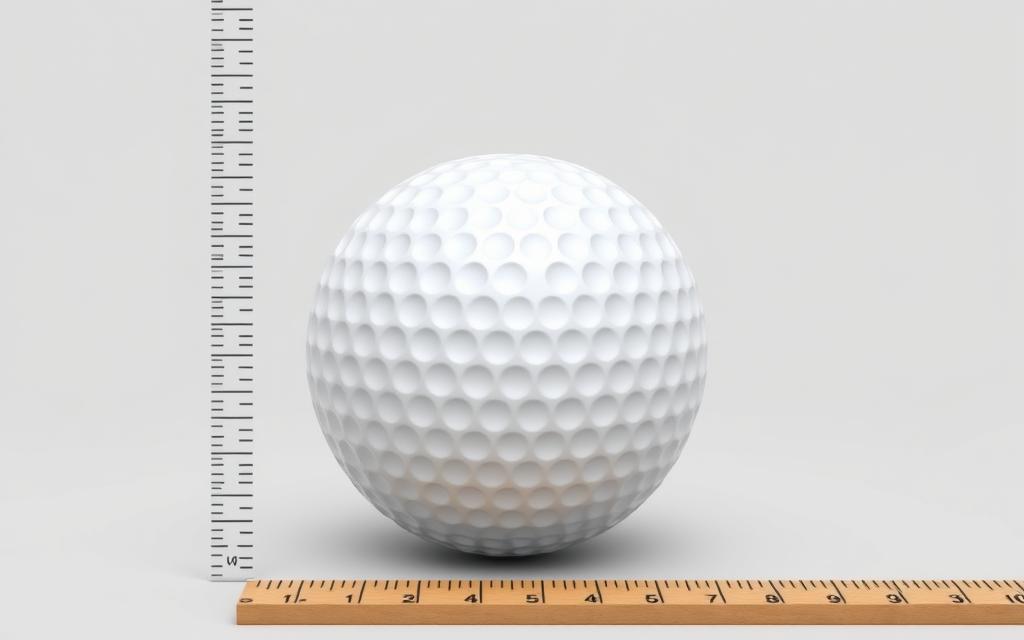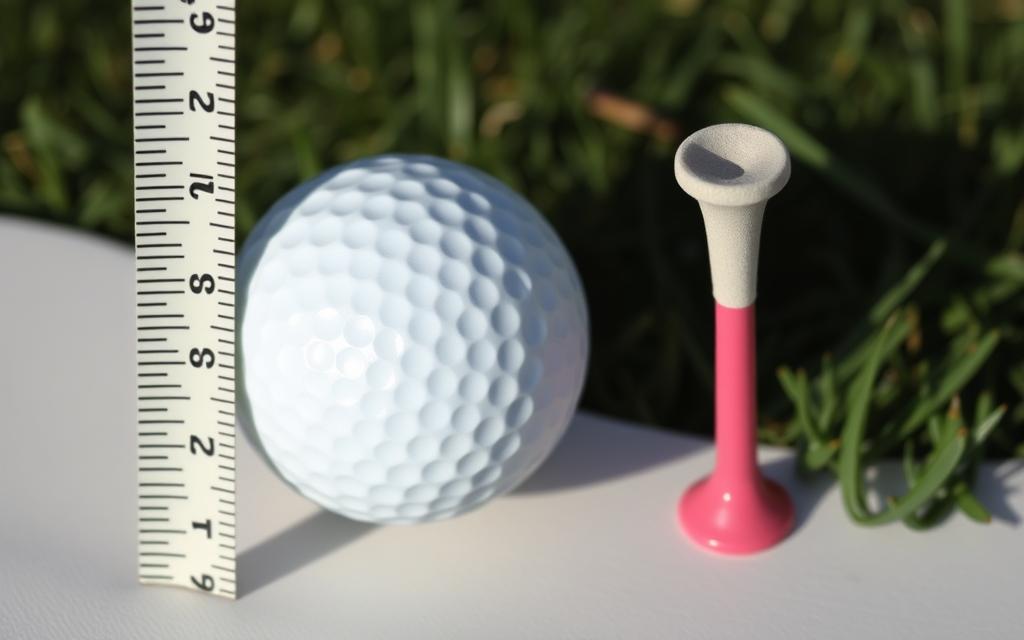Ever thought about a golf ball’s exact size? You know they’re round and fit in your hand. But do you know their exact measurements? In this guide, we’ll look at a golf ball’s standard size, official rules, and how size affects your game.
Knowing a How Many mm Is a Golf Ball? Key to understanding the game. It helps you choose the right ball for your game. The ball’s size can change how far it goes, how it spins, and how well you control it. This all affects your game on the course.
Key Takeaways
- The standard diameter of a golf ball is 1.68 inches or 42.67 millimeters.
- Golf ball size is regulated by organizations like the USGA and R&A to ensure fairness and consistency in the sport.
- Ball size can impact factors such as distance, spin, and control, making it an important consideration for golfers.
- Conversion between inches and millimeters is essential for understanding golf ball dimensions.
- Variations in ball size among brands and custom options offer golfers more choices to suit their individual needs.
Ready to learn more about golf ball size and how it impacts your game? Let’s dive into the details and discover the secrets of these small but important spheres.
Understanding Golf Ball Dimensions
Golf ball size is key to your game. The size of the ball is set to ensure fair play. Knowing the standard size and its role in your game is vital.
Standard Diameter of a Golf Ball
A regulation golf ball is 1.68 inches (42.67 millimeters) in diameter. The USGA and R&A set this size to keep the game fair.
Importance of Size in Golf Performance
The ball’s size affects many parts of the game. Bigger balls go farther, but smaller ones offer more control. Different players choose balls that fit their style.
| Golf Ball Size Specifications | Diameter (Inches) | Diameter (Millimeters) |
|---|---|---|
| Regulation Golf Ball | 1.68 | 42.67 |
| Oversized Golf Ball | 1.72 | 43.69 |
| Midsize Golf Ball | 1.60 | 40.64 |
Understanding golf ball size is key for all players. Knowing the standard size and its impact can help you improve your game.
Official Regulations for Golf Ball Size
The United States Golf Association (USGA) sets the rules for golf ball dimensions. These rules make sure the game is fair and consistent. They are key in making golf equipment dimensions and regulation golf ball dimensions.
Rules Set by the USGA
The USGA’s rules for golf ball size are clear. They say a golf ball must be at least 1.680 inches (42.67 mm) in diameter. This rule is for all golf balls in USGA-sanctioned games and events.
Impact of Regulations on Design
- The USGA’s rules on golf equipment dimensions and regulation golf ball dimensions affect how golf balls are made.
- Companies must make sure their golf balls meet the USGA’s size rules. This means they have to adjust the materials and design of the ball.
- These rules keep the game fair. They stop players from using balls that are too big or too small. This way, no one gets an unfair advantage in distance, trajectory, or spin control.
The USGA’s strict rules for golf equipment dimensions and regulation golf ball dimensions keep the game of golf fair and competitive.

Converting Inches to Millimeters
The golf world is changing fast. It’s key to know the difference between measurement systems. In the U.S., we use inches, but the rest of the world uses millimeters for golf balls. Knowing how to change inches to millimeters helps you understand golf ball sizes better. It also helps when buying or comparing golf gear.
Why Convert Golf Ball Sizes?
Changing golf ball sizes from inches to millimeters has many benefits. It lets players compare balls from different makers. Also, many golf tournaments and groups, like the R&A and USGA, use the metric system. Knowing how to switch between inches and millimeters ensures your gear is up to par.
Quick Conversion Table
| Inches | Millimeters (mm) |
|---|---|
| 1.68 | 42.67 |
| 1.70 | 43.18 |
| 1.72 | 43.69 |
| 1.74 | 44.20 |
| 1.76 | 44.70 |
This table helps you see the millimeter size of golf balls in inches. It makes it easy to find out the millimeter size of a golf ball by its inch size.
Differences in Ball Sizes Among Brands
The golf ball size world is full of variety. The USGA sets the rules, but makers add their own twist. This lets them create balls for all kinds of players. Knowing how different brands size their balls can help you pick the best one for you.
Variations Between Professional Brands
Big names like Titleist, Callaway, and TaylorMade offer many ball sizes. They stick to the USGA’s 1.68-inch rule but tweak it a bit. This helps them make balls that perform just right for tour players:
- Titleist Pro V1 and Pro V1x: 1.680 inches
- Callaway Chrome Soft: 1.681 inches
- TaylorMade TP5 and TP5x: 1.679 inches
Custom Golf Balls and Their Sizes
There are also custom golf balls out there. These balls have special sports equipment sizing for certain players. For example, some are made bigger or smaller for kids or players with special swings.
| Brand | Ball Diameter (inches) |
|---|---|
| Titleist Pro V1 | 1.680 |
| Callaway Chrome Soft | 1.681 |
| TaylorMade TP5 | 1.679 |
| Custom Junior Golf Ball | 1.660 |

“Understanding the subtle differences in ball sizes across brands can help you find the perfect match for your game and playing style.”
The Role of Golf Ball Size in Play
The size of a golf ball greatly affects your game. Knowing how size impacts distance, control, and spin helps choose the right ball. This choice depends on your playing style.
How Size Affects Distance
The standard golf ball size is 1.68 inches (42.67 mm). It’s made to improve distance and trajectory. Bigger balls travel farther because they have more moment of inertia.
This is good for players who find it hard to hit the ball far. The bigger ball gives them an extra push in distance.
Influence on Control and Spin
A bigger ball might help with distance but can hurt control and spin. Smaller balls, slightly under standard size, offer better precision and control. They have less moment of inertia, making shots tighter and with more spin.
This is great for skilled players who want to improve their shots. They can shape their shots better and spin the ball more.
| Ball Size | Diameter (mm) | Distance Impact | Control and Spin |
|---|---|---|---|
| Larger | 42.67+ | Increased distance | Reduced control and spin |
| Standard | 42.67 | Optimal distance | Balanced control and spin |
| Smaller | 42.67- | Reduced distance | Enhanced control and spin |
“The size of the golf ball can have a profound impact on your game, affecting both distance and control. It’s important to find the right balance that suits your playing style and skill level.”
Choosing between a larger, standard, or smaller golf ball size depends on your game needs. Understanding how ball size affects your game helps you make better choices. This way, you can improve your performance on the course.
Measurement Tools for Golf Balls
Measuring golf balls accurately is key for all players. It checks if balls follow rules and how size affects play. The right tools are vital.
Calipers: A Practical Tool
Calipers are top for measuring golf balls. They show the golf ball measurements, like diameter, clearly. You get a digital or analog reading, helping you meet golf equipment dimensions standards.
Rulers and Measuring Tapes
Rulers and measuring tapes are also good for golf ball measurements. They might not be as precise as calipers. But, they’re handy for checking a ball’s diameter, whether it’s official or custom.
“Precise measurements are the foundation of any well-crafted golf equipment.”
Choosing the right tool for measuring golf balls is important. It helps understand how balls perform and if they follow rules. Knowing the right golf ball measurements and golf equipment dimensions can improve your game.
Common Myths About Golf Ball Size
The golf world is full of myths about golf ball size. Many golfers believe things that aren’t true. We’ll look at some common myths and give you the facts for your next game.
Misconceptions in the Golf Community
One myth is that bigger golf balls go farther. But this isn’t true. The standard golf ball size is set by rules, and size doesn’t really matter for distance. The golf ball size specifications don’t affect how well a ball plays.
Another myth is that custom golf balls come in many sizes. While some balls might be a bit different, these differences are small. Most golfers stick with the standard golf ball size, no matter their skill or brand choice.
Facts to Know Before You Play
- The standard golf ball size is about 42.67 millimeters (1.68 inches) in diameter, as set by the USGA and R&A.
- Even if balls are a bit different in size, it doesn’t really change how far they go or how well they spin.
- Custom golf balls might be a bit different, but these small differences don’t give you a big edge.
- Think more about the ball’s make, how hard it is, and how it fits your swing. Don’t worry too much about golf ball size specifications.
Knowing these facts helps you choose the right golf balls. It keeps you from believing in myths that go around in golf.
Choosing the Right Ball for Your Game
Choosing the right golf ball is key to improving your game. You need to think about the ball’s size, how it compresses, and its spin rates. Knowing these details helps you pick the best ball for your game.
Factors to Consider
The size of a golf ball affects how far it goes and how it curves. If you swing slow, a bigger ball might be better. It’s easier to hit and goes farther. But, if you swing fast, a smaller ball could be better. It gives you more control and precision.
The ball’s compression rating is also important. Lower compression balls are good for slow swings. They spin more but don’t go as far. Higher compression balls are for fast swings. They go farther and spin less.
Recommendations for Different Skill Levels
Beginners might do well with a big, low compression ball. It helps them hit the ball farther and gives them more forgiveness. Intermediate players might like a ball that’s medium in size and compression. It balances distance and control well. Advanced players, who swing fast, might prefer a small, high compression ball. It helps them hit the ball farther and more accurately.
Finding the right golf ball is all about your skills, swing, and what you like. Try out different balls and ask for advice from pros or experienced players. This way, you can find the perfect ball to improve your game.
FAQ: How Many mm Is a Golf Ball?
What is the standard diameter of a golf ball?
Golf balls are 42.67 millimeters (1.68 inches) in diameter. This is what the United States Golf Association (USGA) says.
How does golf ball size affect distance and control?
Bigger balls go farther because they have more momentum. Smaller balls give you more spin and control. Your choice should match your skill level and what you like.
Do all golf ball brands have the same size?
While the USGA sets a standard size, different brands might vary a bit. Some professional or custom balls might be slightly different. This is to give them special features and benefits.
How can I convert golf ball size from inches to millimeters?
To change inches to millimeters, remember: 1 inch equals 25.4 millimeters. So, 1.68 inches is 42.67 millimeters.
What are the USGA regulations for golf ball size?
The USGA says a golf ball must be at least 1.68 inches (42.67 mm) in diameter. It also can’t weigh more than 1.62 ounces (45.93 grams). These rules make the game fair for everyone.
Why is the size of a golf ball important?
Golf ball size matters a lot. It affects how far the ball goes, how accurate it is, and how well you can control it. Bigger balls go farther, but smaller ones give you more spin and control.


Pingback: What is the Estimated Volume of a Golf Ball cm3?